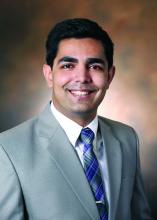People who had taken either of these drugs had a higher risk for cancer, but they also were more likely to have risk factors for this disease such as obesity or a history of smoking, an investigator said.
The findings from Nabeeha Mohyuddin, MD, an internal medicine resident at Allegheny Health Network in Pittsburgh, appear to be at odds with warnings from the U.S. Food and Drug Administration. The FDA in April called on manufacturers to pull all versions of ranitidine because of a problem with probable contamination by human carcinogen n-nitrosodimethylamine (NDMA). The FDA and the European Medicines Agency last year announced investigations of this NDMA contamination.
Dr. Mohyuddin and colleagues used IBM’s Explorys database, which includes data collected from EMRs from more than 40 U.S. health systems, to see if ranitidine use appeared connected to cancer diagnoses. Dr. Mohyuddin presented the findings in an abstract released as part of the annual Digestive Disease Week®, which was canceled because of COVID-19. The researchers identified records for 1.62 million users of ranitidine, 3.37 million users of famotidine, and 59.63 million people who did not use either H2 blocker.
The incidence of cancer was respectively 14.69%, 21.24%, and 5.38% for the ranitidine group, the famotidine group, and the group representing the general population without use of either H2 blocker. Among subjects without risk factors including smoking, obesity, alcohol use, family history, cirrhosis, and gastroesophageal reflux disease, ranitidine users did not have an increased risk of cancer, compared with famotidine users (odds ratio, 0.77; 95% confidence interval, 0.76-0.77; P < .001), Dr. Mohyuddin said in an email interview after her presentation.
“The results need to be interpreted with caution given that this is a retrospective study and it’s the first of its kind,” she said. “Further studies will be definitely needed on this to definitively answer the question, ‘does ranitidine have an increased risk of cancer?’ ”
People in the study who used H2 blockers tended to be older and were more likely to have other risk factors for cancers, according to the abstract:
- Of the ranitidine group, about 33.6% were older than 65, 74.4% were smokers, and 8.9% had a body mass index above 30 kg/m2.
- Of the famotidine group, about 38.3% were older than 65, 76.9% were smokers and 10.8% had a BMI above 30.
- Of the general population, about 23.9% were older than 65, 27.5% were smokers, and 1.69% were obese.
The Explorys database accounts for only 15%-19% of the entire U.S. population and that could be an explanation for why the percentage for obesity in the population seems spuriously low, Dr. Mohyuddin said in an email exchange.
Additionally, it pulls in patients through diagnosis codes, and if a different code for obesity was entered, those patients may not have been accounted for, she said.
Dhyanesh A. Patel, MD, assistant professor of medicine at Vanderbilt University, Nashville, Tenn., said it was a surprise to see the rate of cancer reported for famotidine users in the abstract presented at DDW.
“But these databases are so prone to multiple biases that it’s really hard to tease out. You’d really have to do prospective studies where you follow these patients and then control for variables to know the true risk,” Dr. Patel said in an interview.
In many cases, for example, patients may start on H2 blockers after reporting symptoms that sound like indigestion, Patel said.
“And then the next week, they actually get an upper endoscopy and they get diagnosed with gastric cancer,” Patel said. “In the database, it may seem to be that ranitidine was started and the patient was diagnosed with gastric cancer. So now the gastric cancer gets associated with ranitidine.”
Physicians have had many options to use instead of ranitidine since the FDA last year announced its concerns about the drug, Dr. Patel said.
“Patients can easily switch over to a similar histamine blocker or you can use one of the proton pump inhibitors that haven’t been found to have this impurity in them,” he said. “Both of those are good options for patients.”



